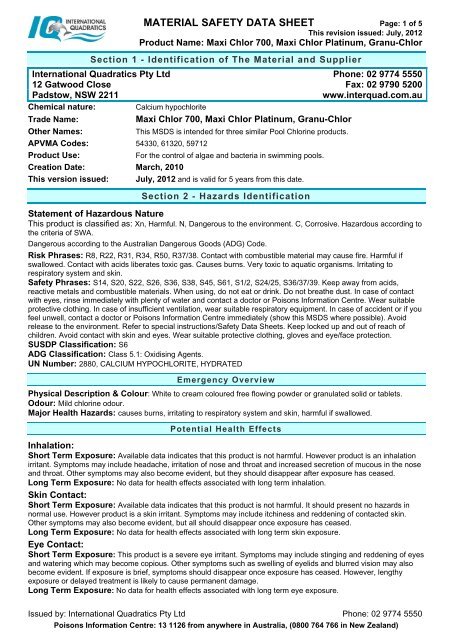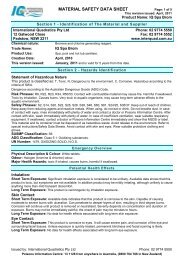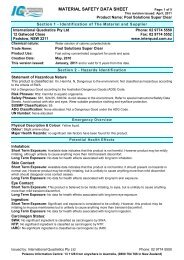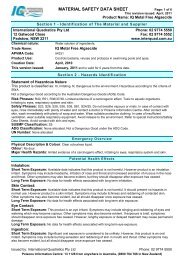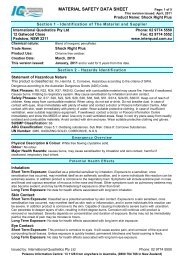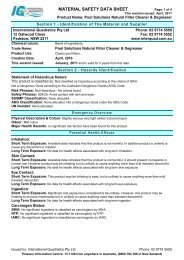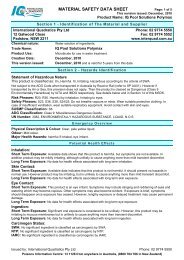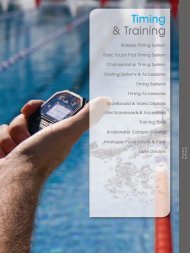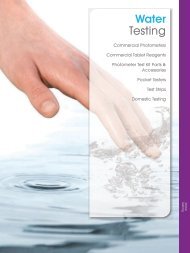IQ Maxi Chlor 700 Granular & Tablets
IQ Maxi Chlor 700 Granular & Tablets
IQ Maxi Chlor 700 Granular & Tablets
You also want an ePaper? Increase the reach of your titles
YUMPU automatically turns print PDFs into web optimized ePapers that Google loves.
MATERIAL SAFETY DATA SHEET Page: 1 of 5This revision issued: July, 2012Product Name: <strong>Maxi</strong> <strong>Chlor</strong> <strong>700</strong>, <strong>Maxi</strong> <strong>Chlor</strong> Platinum, Granu-<strong>Chlor</strong>Section 1 - Identification of The Material and SupplierInternational Quadratics Pty Ltd Phone: 02 9774 555012 Gatwood Close Fax: 02 9790 5200Padstow, NSW 2211www.interquad.com.auChemical nature:Calcium hypochloriteTrade Name:<strong>Maxi</strong> <strong>Chlor</strong> <strong>700</strong>, <strong>Maxi</strong> <strong>Chlor</strong> Platinum, Granu-<strong>Chlor</strong>Other Names:This MSDS is intended for three similar Pool <strong>Chlor</strong>ine products.APVMA Codes: 54330, 61320, 59712Product Use:For the control of algae and bacteria in swimming pools.Creation Date: March, 2010This version issued: July, 2012 and is valid for 5 years from this date.Section 2 - Hazards IdentificationStatement of Hazardous NatureThis product is classified as: Xn, Harmful. N, Dangerous to the environment. C, Corrosive. Hazardous according tothe criteria of SWA.Dangerous according to the Australian Dangerous Goods (ADG) Code.Risk Phrases: R8, R22, R31, R34, R50, R37/38. Contact with combustible material may cause fire. Harmful ifswallowed. Contact with acids liberates toxic gas. Causes burns. Very toxic to aquatic organisms. Irritating torespiratory system and skin.Safety Phrases: S14, S20, S22, S26, S36, S38, S45, S61, S1/2, S24/25, S36/37/39. Keep away from acids,reactive metals and combustible materials. When using, do not eat or drink. Do not breathe dust. In case of contactwith eyes, rinse immediately with plenty of water and contact a doctor or Poisons Information Centre. Wear suitableprotective clothing. In case of insufficient ventilation, wear suitable respiratory equipment. In case of accident or if youfeel unwell, contact a doctor or Poisons Information Centre immediately (show this MSDS where possible). Avoidrelease to the environment. Refer to special instructions/Safety Data Sheets. Keep locked up and out of reach ofchildren. Avoid contact with skin and eyes. Wear suitable protective clothing, gloves and eye/face protection.SUSDP Classification: S6ADG Classification: Class 5.1: Oxidising Agents.UN Number: 2880, CALCIUM HYPOCHLORITE, HYDRATEDEmergency OverviewPhysical Description & Colour: White to cream coloured free flowing powder or granulated solid or tablets.Odour: Mild chlorine odour.Major Health Hazards: causes burns, irritating to respiratory system and skin, harmful if swallowed.Potential Health EffectsInhalation:Short Term Exposure: Available data indicates that this product is not harmful. However product is an inhalationirritant. Symptoms may include headache, irritation of nose and throat and increased secretion of mucous in the noseand throat. Other symptoms may also become evident, but they should disappear after exposure has ceased.Long Term Exposure: No data for health effects associated with long term inhalation.Skin Contact:Short Term Exposure: Available data indicates that this product is not harmful. It should present no hazards innormal use. However product is a skin irritant. Symptoms may include itchiness and reddening of contacted skin.Other symptoms may also become evident, but all should disappear once exposure has ceased.Long Term Exposure: No data for health effects associated with long term skin exposure.Eye Contact:Short Term Exposure: This product is a severe eye irritant. Symptoms may include stinging and reddening of eyesand watering which may become copious. Other symptoms such as swelling of eyelids and blurred vision may alsobecome evident. If exposure is brief, symptoms should disappear once exposure has ceased. However, lengthyexposure or delayed treatment is likely to cause permanent damage.Long Term Exposure: No data for health effects associated with long term eye exposure.Issued by: International Quadratics Pty Ltd Phone: 02 9774 5550Poisons Information Centre: 13 1126 from anywhere in Australia, (0800 764 766 in New Zealand)
MATERIAL SAFETY DATA SHEET Page: 2 of 5This revision issued: July, 2012Product Name: <strong>Maxi</strong> <strong>Chlor</strong> <strong>700</strong>, <strong>Maxi</strong> <strong>Chlor</strong> Platinum, Granu-<strong>Chlor</strong>Ingestion:Short Term Exposure: Significant oral exposure is considered to be unlikely. Available data shows that thisproduct is harmful, but symptoms are not available. However, this product is a severe oral irritant. Symptoms mayinclude extreme pain and reddening of skin in mouth and throat. Other symptoms such as blisters may also becomeevident, and may last long after exposure has ceased.Long Term Exposure: No data for health effects associated with long term ingestion.Carcinogen Status:SWA: No significant ingredient is classified as carcinogenic by SWA.NTP: No significant ingredient is classified as carcinogenic by NTP.IARC: No significant ingredient is classified as carcinogenic by IARC.Section 3 - Composition/Information on IngredientsIngredients CAS No Conc,% TWA (mg/m 3 ) STEL (mg/m 3 )Calcium hypochlorite 7778-54-3 <strong>700</strong>g/kg not set not setThis is a commercial product whose exact ratio of components may vary slightly. Minor quantities of other nonhazardous ingredients are also possible.The SWA TWA exposure value is the average airborne concentration of a particular substance when calculated over a normal 8 hour working dayfor a 5 day working week. The STEL (Short Term Exposure Limit) is an exposure value that may be equalled (but should not be exceeded) for nolonger than 15 minutes and should not be repeated more than 4 times per day. There should be at least 60 minutes between successive exposuresat the STEL. The term "peak "is used when the TWA limit, because of the rapid action of the substance, should never be exceeded, even briefly.Section 4 - First Aid MeasuresGeneral Information:You should call The Poisons Information Centre if you feel that you may have been poisoned, burned or irritated bythis product. The number is 13 1126 from anywhere in Australia (0800 764 766 in New Zealand) and is available at alltimes. Have this MSDS with you when you call.Inhalation: If irritation occurs, contact a Poisons Information Centre, or call a doctor. Remove source ofcontamination or move victim to fresh air. If breathing is difficult, oxygen may be beneficial if administered by trainedpersonnel, preferably on a doctor's advice. In severe cases, symptoms of pulmonary oedema can be delayed up to 48hours after exposure.Skin Contact: Quickly and gently brush away excess solids. Wash gently and thoroughly with warm water (use nonabrasivesoap if necessary) for 10-20 minutes or until product is removed. Under running water, remove contaminatedclothing, shoes and leather goods (e.g. watchbands and belts) and completely decontaminate them before reuse ordiscard. If irritation persists, repeat flushing and seek medical attention.Eye Contact: Quickly and gently brush particles from eyes. Immediately flush the contaminated eye(s) withlukewarm, gently flowing water for 20 minutes or until the product is removed, while holding the eyelid(s) open. Takecare not to rinse contaminated water into the unaffected eye or onto the face. Obtain medical attention immediately.Take special care if exposed person is wearing contact lenses.Ingestion: If swallowed, do NOT induce vomiting. Wash mouth with water and contact a Poisons InformationCentre, or call a doctor.Section 5 - Fire Fighting MeasuresFire and Explosion Hazards: There is a moderate risk of an explosion from this product if commercial quantitiesare involved in a fire. Firefighters should take care and appropriate precautions. The presence of this product in a fireis likely to intensify the fire due to its oxidising properties.Fire decomposition products from this product may be toxic if inhaled. Take appropriate protective measures.Extinguishing Media: Not Combustible. Use extinguishing media suited to burning materials. Coarse water sprayis the preferred medium for large fires. Try to contain spills, minimise spillage entering drains or water courses.Fire Fighting: If a significant quantity of this product is involved in a fire, call the fire brigade. There is a danger of aviolent reaction or explosion if significant quantities of this product are involved in a fire. Recommended personalprotective equipment is liquid-tight chemical protective clothing and breathing apparatus.Flash point:Does not burn.Upper Flammability Limit: Does not burn.Lower Flammability Limit: Does not burn.Autoignition temperature: Not applicable - does not burn.Flammability Class: Does not burn.Issued by: International Quadratics Pty Ltd Phone: 02 9774 5550Poisons Information Centre: 13 1126 from anywhere in Australia, (0800 764 766 in New Zealand)
MATERIAL SAFETY DATA SHEET Page: 3 of 5This revision issued: July, 2012Product Name: <strong>Maxi</strong> <strong>Chlor</strong> <strong>700</strong>, <strong>Maxi</strong> <strong>Chlor</strong> Platinum, Granu-<strong>Chlor</strong>Section 6 - Accidental Release MeasuresAccidental release: This product is sold in small packages, and the accidental release from one of these is notusually a cause for concern. For minor spills, clean up, rinsing to sewer and put empty container in garbage. Althoughno special protective clothing is normally necessary because of occasional minor contact with this product, it is goodpractice to wear impermeable gloves when handling chemical products. In the event of a major spill, prevent spillagefrom entering drains or water courses and call emergency services.Section 7 - Handling and StorageHandling: Keep exposure to this product to a minimum, and minimise the quantities kept in work areas. CheckSection 8 of this MSDS for details of personal protective measures, and make sure that those measures are followed.The measures detailed below under "Storage" should be followed during handling in order to minimise risks topersons using the product in the workplace. Also, avoid contact or contamination of product with incompatiblematerials listed in Section 10.Storage: This product is a Scheduled Poison. Observe all relevant regulations regarding sale, transport and storageof this schedule of poison. Store in a cool, well ventilated area. Check containers periodically for corrosion and leaks.Containers should be kept closed in order to minimise contamination, especially from combustible or reducingmaterials. Make sure that the product does not come into contact with or substances listed under "Incompatibilities" inSection 10. If you keep more than 50kg of Dry Pool <strong>Chlor</strong>ine, you are probably required to license the premises ornotify your Dangerous Goods authority. If you have any doubts, we suggest you contact your Dangerous Goodsauthority in order to clarify your obligations. Check packaging - there may be further storage instructions on the label.Section 8 - Exposure Controls and Personal ProtectionThe following Australian Standards will provide general advice regarding safety clothing and equipment:Respiratory equipment: AS/NZS 1715, Protective Gloves: AS 2161, Industrial Clothing: AS2919, Industrial EyeProtection: AS1336 and AS/NZS 1337, Occupational Protective Footwear: AS/NZS2210.SWA Exposure Limits TWA (mg/m 3 ) STEL (mg/m 3 )Exposure limits have not been established by SWA for this product.No special equipment is usually needed when occasionally handling small quantities. The following instructions arefor bulk handling or where regular exposure in an occupational setting occurs without proper containment systems.Ventilation: This product should only be used in a well ventilated area. If natural ventilation is inadequate, use of afan is suggested.Eye Protection: Protective glasses or goggles must be worn when this product is being used. Failure to protectyour eyes may lead to severe harm to them or to general health. Emergency eye wash facilities must also beavailable in an area close to where this product is being used.Skin Protection: Prevent skin contact by wearing impervious gloves, clothes and, preferably, apron. Make sure thatall skin areas are covered. See below for suitable material types.Protective Material Types: We suggest that protective clothing be made from the following materials: rubber,PVC, Viton.Respirator: If there is a significant chance that dusts are likely to build up in the area where this product is beingused, we recommend that you use a suitable Dust Mask.Safety deluge showers should, if practical, be provided near to where this product is being used.Physical Description & colour:Odour:Boiling Point:Freezing/Melting Point:Volatiles:Vapour Pressure:Vapour Density:Specific Gravity:Water Solubility:pH:Volatility:Odour Threshold:Evaporation Rate:Coeff Oil/water Distribution:Section 9 - Physical and Chemical Properties:White to cream coloured free flowing powder or granulated solid or tablets.Mild chlorine odour.Not applicable.Decomposes before melting.Nil at 100°C.Negligible at normal ambient temperatures.No data.No data.Moderately soluble.No data, but known to be alkaline.Negligible at normal ambient temperatures.No data.No data.No dataIssued by: International Quadratics Pty Ltd Phone: 02 9774 5550Poisons Information Centre: 13 1126 from anywhere in Australia, (0800 764 766 in New Zealand)
Autoignition temp:MATERIAL SAFETY DATA SHEET Page: 4 of 5This revision issued: July, 2012Product Name: <strong>Maxi</strong> <strong>Chlor</strong> <strong>700</strong>, <strong>Maxi</strong> <strong>Chlor</strong> Platinum, Granu-<strong>Chlor</strong>Not applicable - does not burn.Section 10 - Stability and ReactivityReactivity: This product is unlikely to react or decompose under normal storage conditions. However, if you haveany doubts, contact the supplier for advice on shelf life properties. Check the Safety Directions on the product labelfor further details of incompatabilities.Conditions to Avoid: This product should be kept in a cool place, preferably below 30°C. Keep containers tightlyclosed. Containers should be kept dry. Keep containers and surrounding areas well ventilated. Keep isolated fromcombustible materials.Incompatibilities: acids, strong reducing agents, zinc, tin, aluminium and their alloys, combustible materials.Fire Decomposition: May form hydrogen chloride gas, other compounds of chlorine. calcium compounds.Polymerisation: This product will not undergo polymerisation reactions.Section 11 - Toxicological InformationLocal Effects:Target Organs:There is no data to hand indicating any particular target organs.Classification of Hazardous IngredientsIngredientCalcium HypochloriteRisk PhrasesConc>=25%: C; R34; R22Section 12 - Ecological InformationThis product is very toxic to aquatic organisms. This product is unlikely to adversely effect the environment. Salts,acids and bases are typically diluted and neutralised when released to the environment in small quantities.Section 13 - Disposal ConsiderationsDisposal: Dispose of small quantities and empty containers by wrapping with paper and putting in garbage. Forlarger quantities, if recycling or reclaiming is not possible, use a commercial waste disposal service.Section 14 - Transport InformationADG Code: 2880, CALCIUM HYPOCHLORITE, HYDRATEDHazchem Code: 1WSpecial Provisions: 316Limited quantities: ADG 7 specifies a Limited Quantity value of 5 kg for this class of product.Dangerous Goods Class: Class 5.1: Oxidising Agents.Packaging Group: IIIPackaging Method: P002, IBC08Class 5.1 Oxidising Agents shall not be loaded in the same vehicle or packed in the same freight container withClasses 1 (Explosives), 2.1 (Flammable Gases), 2.3 (Toxic Gases), 3 (Flammable Liquids), 4.1 (Flammable Solids),4.2 (Spontaneously Combustible Substances), 4.3 (Dangerous When Wet Substances), 5.2 (Organic Peroxides), 6(Toxic Substances, where the Toxic Substance is a fire risk substance), 7 (Radioactive Substances), 8 (CorrosiveSubstances), 9 (Miscellaneous Dangerous Goods, where the substance is a fire risk substance), Fire risk substancesother than Dangerous Goods. They may however be loaded in the same vehicle or packed in the same freightcontainer with Classes 2.2 (Non-Flammable, Non-Toxic Gases), 6 (Toxic Substances except where the substancesare fire risk substances), 9 (Miscellaneous Dangerous Goods except where the goods are fire risk substances)Foodstuffs and foodstuff empties.Section 15 - Regulatory InformationAICS: This product is compliant with NICNAS regulations.The following ingredient: Calcium hypochlorite, is mentioned in the SUSDP.Acronyms:Section 16 - Other InformationThis MSDS contains only safety-related information. For other data see product literature.Issued by: International Quadratics Pty Ltd Phone: 02 9774 5550Poisons Information Centre: 13 1126 from anywhere in Australia, (0800 764 766 in New Zealand)
ADG CodeAICSSWACAS numberHazchem CodeIARCNOSNTPR-PhraseSUSDPUN NumberMATERIAL SAFETY DATA SHEET Page: 5 of 5This revision issued: July, 2012Product Name: <strong>Maxi</strong> <strong>Chlor</strong> <strong>700</strong>, <strong>Maxi</strong> <strong>Chlor</strong> Platinum, Granu-<strong>Chlor</strong>Australian Code for the Transport of Dangerous Goods by Road and Rail (7 th edition)Australian Inventory of Chemical SubstancesSafe Work Australia, formerly ASCC and NOHSCChemical Abstracts Service Registry NumberEmergency action code of numbers and letters that provide information to emergencyservices especially firefightersInternational Agency for Research on CancerNot otherwise specifiedNational Toxicology Program (USA)Risk PhraseStandard for the Uniform Scheduling of Drugs & PoisonsUnited Nations NumberTHIS MSDS SUMMARISES OUR BEST KNOWLEDGE OF THE HEALTH AND SAFETY HAZARD INFORMATION OF THE PRODUCT ANDHOW TO SAFELY HANDLE AND USE THE PRODUCT IN THE WORKPLACE. EACH USER MUST REVIEW THIS MSDS IN THE CONTEXT OFHOW THE PRODUCT WILL BE HANDLED AND USED IN THE WORKPLACE.IF CLARIFICATION OR FURTHER INFORMATION IS NEEDED TO ENSURE THAT AN APPROPRIATE RISK ASSESSMENT CAN BE MADE,THE USER SHOULD CONTACT THIS COMPANY SO WE CAN ATTEMPT TO OBTAIN ADDITIONAL INFORMATION FROM OUR SUPPLIERSOUR RESPONSIBILITY FOR PRODUCTS SOLD IS SUBJECT TO OUR STANDARD TERMS AND CONDITIONS, A COPY OF WHICH IS SENTTO OUR CUSTOMERS AND IS ALSO AVAILABLE ON REQUEST.Please read all labels carefully before using product.This MSDS is prepared in accord with the SWA document “National Code of Practice for the Preparation ofMaterial Safety Data Sheets” 2nd Edition [NOHSC:2011(2003)]Copyright © Kilford & Kilford Pty Ltd, July, 2012.http://www.kilford.com.au/ Phone (02)9251 4532Issued by: International Quadratics Pty Ltd Phone: 02 9774 5550Poisons Information Centre: 13 1126 from anywhere in Australia, (0800 764 766 in New Zealand)


